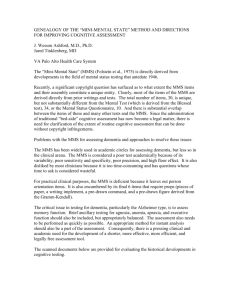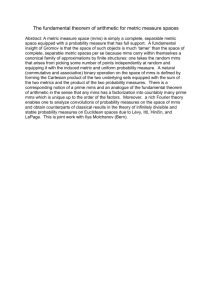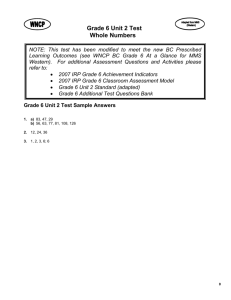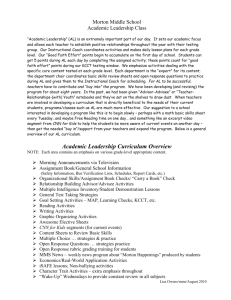1-202
advertisement
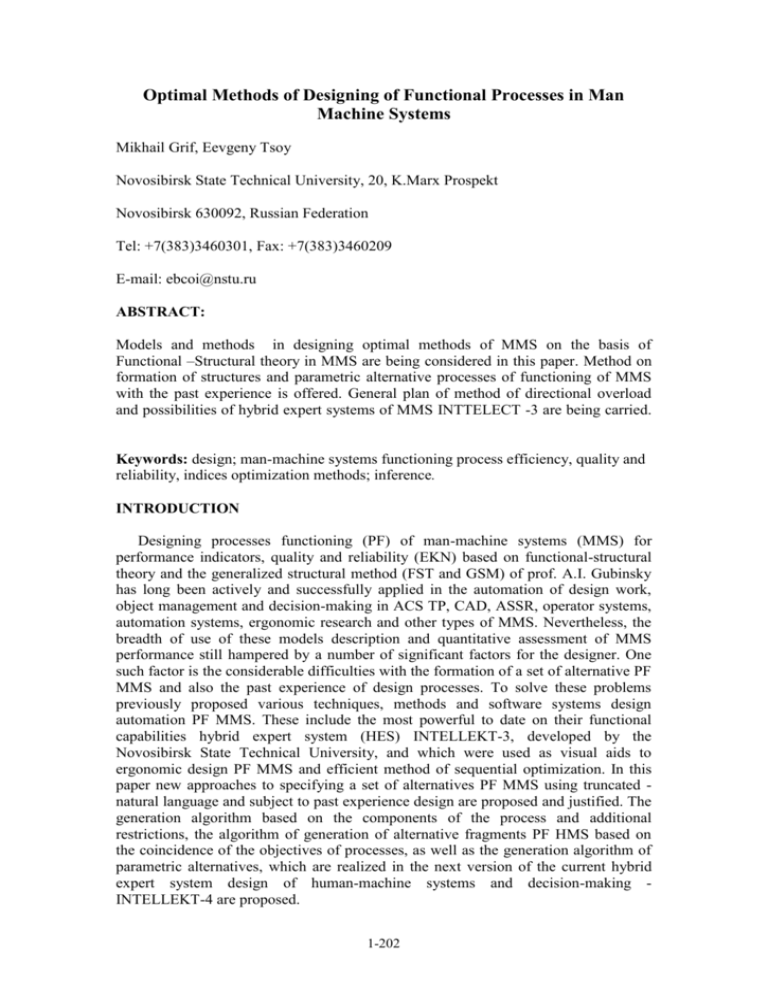
Optimal Methods of Designing of Functional Processes in Man
Machine Systems
Mikhail Grif, Eevgeny Tsoy
Novosibirsk State Technical University, 20, K.Marx Prospekt
Novosibirsk 630092, Russian Federation
Tel: +7(383)3460301, Fax: +7(383)3460209
E-mail: ebcoi@nstu.ru
ABSTRACT:
Models and methods in designing optimal methods of MMS on the basis of
Functional –Structural theory in MMS are being considered in this paper. Method on
formation of structures and parametric alternative processes of functioning of MMS
with the past experience is offered. General plan of method of directional overload
and possibilities of hybrid expert systems of MMS INTTELECT -3 are being carried.
Keywords: design; man-machine systems functioning process efficiency, quality and
reliability, indices optimization methods; inference.
INTRODUCTION
Designing processes functioning (PF) of man-machine systems (MMS) for
performance indicators, quality and reliability (EKN) based on functional-structural
theory and the generalized structural method (FST and GSM) of prof. A.I. Gubinsky
has long been actively and successfully applied in the automation of design work,
object management and decision-making in ACS TP, CAD, ASSR, operator systems,
automation systems, ergonomic research and other types of MMS. Nevertheless, the
breadth of use of these models description and quantitative assessment of MMS
performance still hampered by a number of significant factors for the designer. One
such factor is the considerable difficulties with the formation of a set of alternative PF
MMS and also the past experience of design processes. To solve these problems
previously proposed various techniques, methods and software systems design
automation PF MMS. These include the most powerful to date on their functional
capabilities hybrid expert system (HES) INTELLEKT-3, developed by the
Novosibirsk State Technical University, and which were used as visual aids to
ergonomic design PF MMS and efficient method of sequential optimization. In this
paper new approaches to specifying a set of alternatives PF MMS using truncated natural language and subject to past experience design are proposed and justified. The
generation algorithm based on the components of the process and additional
restrictions, the algorithm of generation of alternative fragments PF HMS based on
the coincidence of the objectives of processes, as well as the generation algorithm of
parametric alternatives, which are realized in the next version of the current hybrid
expert system design of human-machine systems and decision-making INTELLEKT-4 are proposed.
1-202
POBLEM DEFINITION
Under the process of functioning MMS meaning the logic-temporal sequence of
actions and operations ergatic and non-ergatic elements of the system that is stable to
perturbations and leads to achieving the goal (or goals) of functioning [1,2,3].
Using the design of PF MMS FST and GSM of A.I. Gubinsky assumes that each
alternative process functioning MMS is specified as a functional network (FN) [1]. A
functional network (Fig. 1) is a binary relation RFS (Oi , O j ),...on the set of
operations O where the operation O O(F , E, S ) M TFE is a process to perform the
function F by element E in a state of MMS S .
Fig.1. Submission PF MMS as FS
PF appears to consist of a number of formal units - standard functional units
(TFE) (actual operations or actions of a person).
Each TFE includes the mandatory parameters: the set of functions (purposes), the
set of elements (people, technology) and characteristics of the execution. User
describes many alternative processes MMS as an alternative graph [3]. Entering of the
alternative graph in the system INTELLEKT-3 is carried out manually by the user and
each level of the hierarchy is described by them independently.
Initially, the system did not have language with sufficient simplicity, and
therefore, face the task of creating a more comfortable language input, which would
include not only the basic parameters, but also the additional data required for a user
to specify a process or a fragment of the process [2]. The overall objective is to
organize storage of previously solved problems, and the further development of
alternatives sets of MMS operation as a fragment of the process or a whole process,
taking into account constraints and objectives based on past experience.
KNOWLEDGE REPRESENTATION MODEL
For knowledge representation on the basis of truncated natural language model the
hierarchy of classes and objects is chosen [5].
The object has state, behavior and personality. The structure of similar objects
behavior defines the overall class for them. Class - a set of objects, linked by the
structure and behavior.
The principal difference between the class objects - each attribute of them have a
specific value from the set of possible values, including, perhaps, the name of a class.
The ongoing events can be arbitrary, but their treatment is to change the values of
objects attributes of class [1,5,6]. Each object, entered by users, is a composite object
containing necessary parameters of a specific class [4,7].
Self-assignment classes, allows users substantially narrow the search and organize
data in a common format for all the described processes, and facilitates the search for
the previously described processes.
By composition means the set of objects, united to perform a specific operation.
Extend the concept of operations O O(FO , EO , QO , DO ) , M E many elements of
MMS. E O M E , - element contains a set of objects EO RE ( E1 , E 2 ,.., E n ), Ei M E , i
=1.. n, the ration RE is a logical expression - operation «AND».
1-203
Ei ( Ei , PEO ) . PEo
i
i
-
parameters (characteristics) of simple elements Ei M E , not connected with the
implementation element of any function.
FO - function performed by element. FO R F ( F1, F2 ,.., Fn ) , Fi M E , i =1..n, the
ratio RF is a logical expression - operation «AND».
QO - factors affecting the implementation of an operation (ambient conditions).
QO RQ (Q1, Q2 ,..,Qn ), Qi M E , i =1..n, RQ the ratio is a logical expression - operation
«AND».
DO - additional features of the process (goal). DO R D ( D1, D2 ,.., Dn ), Di M E , i
=1..n, RD is a logical expression - operation «AND».
A separate process operation MMS (functional network) s represented as a
superposition of TFS:
OZ TFS i (Oi1 , Oi1 ,.., Oik ), Fi M E ,
(1)
where ТFS i M ТFS , Oi j - operation.
Thus, the user is able to process job TFE, incorporate into it a set of objects of
different nature (people, technology, external factors), which he consider appropriate,
purpose, and some additional parameters defined by the user.
THE METHOD OF PARAMETRIC ALTERNATIVES GENERATION
This algorithm is based on the notion of a composition-template, as well as the
degree of closeness compositions. The composition-template can be any previously
defined operation, which may not be only executable function, the person performing
the operation, the purpose and conditions of the environment, but also the specific
characteristics of their values. Lists of compositions in the order of closeness are
given on the basis of composition-template, from which users can select only those
that are needed in solving a particular problem.
The degree of closeness is calculated from the following relationship:
Ns
, where N s - number of objects K Os and corresponding characteristics of the
No
compositions K Cs : N s KOs K Cs , N o - total number of objects K Oo
and
characteristics (with values, if any) consideration of K Co : No KOo KCo .
N s - determined in accordance with the objects and their characteristics, that
verify the compliance of specific sites under consideration of the objects of the
template.
N O - the number of objects being compared the composition, the values of the
characteristics of which coincide with the values of the main characteristics of the
template.
1-204
Fig. 2. The possible parametric alternatives generation
The algorithm of parametric alternatives generation:
START
STEP 1: No KOo KCo , N s =0
STEP 2: The choice of the template user from database
STEP 3: Selecting a list of compositions that have at least one object in the
composition, the same as that of the template
STEP 4: CYCLE FOR (i=0; i<= K Oo ; i++)
STEP 5: CYCLE FOR (o=0; o<= K Os ; o++)
STEP 6: If the objects are similar
STEP 7: N s N s 1
STEP 8: CYCLE FOR (h=0; h< K Co ; h++)
STEP 9: CYCLE FOR (h1=0; h1< K Co ; h1++)
STEP 10: If the characteristics are similar
STEP 11: N s N s 1
STEP 12: If the values of characteristics are similar
STEP 13: N s N s 1
STEP 14: ELSE;
STEP 15: ELSE;
STEP 16: END CYCLE;
STEP 17: END CYCLE;
STEP 18: ELSE;
STEP 19: o
Ns
- расчет степени близости
No
STEP 20: END CYCLE;
STEP 21: END CYCLE;
STEP 22: Output of results in descending order of degree of proximity
STEP 23: CHOICE users should, in his opinion, alternatives
STEP 24: UPLOAD current TFS
STEP 25: END
The degree of proximity would more accurately determine the level of objects
compositions similarity for a more complete understanding of certain compounds
similarity by users and help in the selection of similar composition as the alternatives
(Fig. 2)
1-205
THE METHOD OF GENERATION FRAGMENTS OF OPERATION
We say that two operations with the same purpose Z - O( F , E1 , Q1 ) and O( F , E2 , Q2 )
are alternative (parametric) way of accomplishing O , as well as composite operations
OТFSi (Oi , Oi ,...) and OТFS s (Os , Os ,...) , i s - “structural".
1
2
1
2
Consider the process of functioning of MMS in the form of a directed
graph G G(V , E) , where V { ТFE1 , ТFE2 , ТFE3 ,..., ТFEi } - vertices, ТFEi - TFE
equivalent OZ of (1),
E {( ТFE1, ТFE2 ), ( ТFEE 2 , ТFE3 ),..., ( ТFEi 1, ТFEi )}
- edges
If ( ТFEi 1 , ТFEi ) E , then ТFEi 1 called the initial vertex, and ТФЕ i terminal vertex.
A directed graph G G ' (V ' , E ' ) is called oriented sub graph (fragment of the
process), directed graph G G(V , E ) , denoted G G ' (V ' , E ' )G(V , E) , if V ' V and
E ' E . Thus, each vertex in G ' is a vertex in G and each directed edge in G ' is an
oriented edge.
The challenge is to ensure that the user has the opportunity to ask not only for the
graph purpose as a whole, but also for sub graphs contained in it. In addition, the
creation of alternative options for the selected user based on sub graph matching.
The algorithm set goals for the fragment of the process
STEP 1: START
STEP 2: Select the user the initial and final state of a fragment of the
implementation of goals
STEP 3: IF there is objective
STEP 4: If we replace the goal
STEP 5: Go to STEP6
STEP 6: ELSE go to STEP7
STEP 7: Fragment selection from the initial to the final point
STEP 8: Goal record for a fragment
STEP 9: END
Algorithm for finding alternatives on the basis of coincidence purpose of the
operation for the process fragment:
STEP 1: START
STEP 2: Select the user the initial and final state of a fragment of the
implementation of goals
STEP 3: If there is objective
STEP 4: Go to STEP6
STEP 5: ELSE Setting goals
STEP 7: THE PROCESS of finding fragments of the processes in the database
STEP 8: IF there is an alternative
STEP 9: CONCLUSION user
STEP 10: SELECT users list of suitable alternatives
STEP 11: UPLOAD suitable alternatives to the chosen start to finish]
STEP 12: ELSE go to STEP 13
STEP 13: END
1-206
Based on the previously saved graphs with processes fragments with the described
purposes, the user has the ability to generate alternatives for a particular piece of the
process chosen by them from the point of beginning to the end point.
The system automatically prompts the user for the purpose of possible processes
fragments that he can view and insert as alternatives. When the user has not yet
defined the graph, but knows only the goal of the whole process, he also has the
possibility to get the possible solution of the problem, based on early experiences on
the basis of common graphs goals and their constituent fragments.
Storing parts of a graph with goals enables you to store structured information
to quickly locate parts of the process on the basis of previously entered targets.
Generation of alternatives based on the goals can find alternative processes at any part
of the main process selected by the user.
METHOD AUTOMATICALLY GENERATE SEQUENCE-PARALLEL PROCESSES
M {O1 , O2 ,..., On } – a set of abstract operations that differ from each other a unique
name (or number), n - total number of operations.
R { Oi , O j / Oi RO j Oi O j ; Oi , O j M }, R M 2
binary relation on the set of M 2
«follow» (the operation of Oi the next operation O j ), sets the ratio of the sequence on
the set M [11].
Define a series - parallel structure (algorithm) of man-machine systems operation
process functioning. To do this, you must divide the set M into m disjoint subsets
such Pi that every element of M belongs to only one of these subsets:
P P1 , P2 ,..., Pm
(2)
where m – the number of subsets P;
1) i Pi M ;
2) ij i j Pi P j ;
3)
P M ;
i
i 1, m
4)
Os1 Pj andOs2 Pi and j i, i j Os1 R Os2
;
5) for thecar dinality Pi 1 : O s and O s Pi O s RO s .
1
2
1
2
We seek to maximize parallelize sequential-parallel algorithm (2), which
corresponds to the minimum possible value m (which satisfies 1) to 5)):
m min .
(3)
We introduce a square matrix for the relationship R - A aij , where i, j 1, n
and aij 1 Oi R O j . This matrix is the adjacency matrix. On this basis we find the
matrix of attainable A ' a'ij , where i, j 1, n , a' ij 1 O j reachable from Oi .
Example: for M {Oi / i 1,3}, the adjacency matrix and reachability:
1-207
0 1 0
0 1 1
A 0 0 1 , A' 0 0 1 .
0 0 0
0 0 0
For convenient representation and minimize the memory represent a matrix A ' of
a set of lists S i , where i 1, n :
S i {Os M / a'is 1}
(4)
Then, on the basis of A ' examples:
S1 {O2 , O3 } ;
S 2 {O3 } ;
S3 .
Definition 1: i, j Oi и O j - be parallel O j Si и Oi S j .
Generation algorithm for the process in the form of a series-parallel connections,
taking into account environmental factors and a person who performs a given
operation
START
STEP 1: m 1, Pm M all operations in parallel, k n, col 0, parall true;
STEP 2:
CYCLE FOR (i 0; i k; i ) parall true
STEP 3: IF Oi S i 1 и Oi 1 S i
IF selected verification of environmental factors
IF FOi FO
i 1
IF Z FO Z FO
i
i 1
parall false ;
STEP 4: IF parall true reserve operations in a subset Pm
ELSE IF Oi S i 1 - memorize vertex O i , col col 1;
ELSE IF Oi 1 S i - memorize vertex Oi 1 , col col 1;
ELSE memorize vertex Oi 1 , col col 1;
END CYCLE
STEP 5: We form from the resulting list separately issued a new subset of
vertices: m m 1, Pm , k col, col 0;
STEP 6: Go to STEP 2, WHILE reviewed all operations
STEP 7: We connect the resulting subsets
structure: P1 , P2 ,..., Pm .
END
1-208
of
a
series-parallel
Implemented software algorithms for series-parallel connections generation were
integrated into the system INTELLEKT-3. Introduction of series-parallel connections
based on the process representation of the system INTELLEKT-3.
The user can specify a route between the operations, to establish control over the
entire process, as well as to select those environmental factors that must be considered
in the generation process.
ACKNOWLEDGMENT
The article describes a method of presenting data in the system INTELLEKT-4
on the basis of truncated natural language, is a formal description, a method for the
generation of parametric alternatives, structural alternatives, based on matching of the
operations goals, the generation of a full series - parallel PF MMS with additional
restrictions.
The method of processes generation, taking into account matching of the
operation goals, allow users automatically get an idea of the process (or its separate
parts - the fragment) as an early goals operations saved fragments based on alternative
graph. In addition, the use of goals allows to take into account past experience more
efficiently and found possible problems solutions by selection of the most optimal
alternatives.
The developed algorithm for generating a series-parallel PF MMS maximizes
parallelize operations to reduce time spent by the user in the process and take into
account environmental factors, excluding the paralleling operations situations when
operations are performed in different conditions.
REFERENCES
[1] Anderson, James A. Discrete mathematics and combinatorics.: Trans. From angl.M.: Publishing House "Williams", 2004.-960p.
[2] A.I. Gubinsky Reliability and performance for ergatic systems. - L.: Nauka, 1982.
- 270 p
[3] Grif M.G., Tsoy E.B. Computer-aided design processes, the functioning of manmachine systems based on the method of sequential optimization. - Novosibirsk:
Publishing House NSTU, 2005. - 264 p.
[4] Grif M.G. Modern design methods ICS / manual. Novosibirsk: Izd NSTU, 2003. –
84p.
[5] A.N. Adamenko Information and control man-machine systems: Research, design,
test: Directory / A.N. Adamenko, A.T. Asherov, IL Berdnikov et al; Under
commonly. Ed. A.I. Gubinsky and V.G. Evgrafova. - M.: Mashinostroenie, 1993.
- 528 p.
[6] Grif M.G., Geniatulina E.V. Methods of knowledge representation in intelligent
systems / / Proceedings of the NSTU № 2 (56), Novosibirsk, Novosibirsk State
Technical universistet, 2009. - P.87-92
[7] Grif M.G., Geniatulina E.V. The method of generation processes functioning manmachine systems on the basis of truncated natural language / Proceedings of the
NSTU № 4 (58), Novosibirsk, Novosibirsk State Technical universistet, 2009. .29-35p.
[8] Geniatulina E.V. Presentation of information in intelligent systems, truncated
natural language: Proceedings of the ninth international scientific-methodical
1-209
conference. Computers: problems, methodology, technology T1. Voronezh,
Voronezh State University, 2009 .- 202-206p.
[9] Geniatulina E.V. The method of generation processes functioning man-machine
systems in intelligent systems / / "Young Scientist» № 10, Chita, LLC Publishing
Young Scientist », ISSN 2070-0297, 2009. - 83 – 85p.
[10] Geniatulina E.V. The method of generation of man-machine systems operation
in artificial intelligence systems / Automation systems in education, science and
industry: Proceedings of the VII All-Russian scientific-practical conference. Novokuznetsk: SibGIU, 2009 .- 375-378p.
[11] Geniatulina E.V. Presentation of information in intelligent systems, truncated
natural language: Proceedings of the ninth international scientific-methodical
conference. Computers: problems, methodology, technology T1. Voronezh,
Voronezh State University, 2009 .- 202-206p.
[12] Geniatulina E.V., Grif M.G.., The method of forming the set of man-machine
systems operation alternatives, "Systems analysis in the design and management:
Proceedings of the XII Intern. scientific-practical. Conf. Part 1. SPb., Izd
Polytechnic. Univ, 2008. - 148 – 150p.
[13] Anderson, James A. Discrete mathematics and combinatorics.: Trans. From
angl.-M.: Publishing House "Williams", 2004.-960p.
1-210
